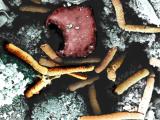Aug 10, 2011 (CIDRAP News) – An investigation into the origins of Minnesota's first human anthrax case in many years is focusing on where the patient might have been exposed to the deadly pathogen, Minnesota State Epidemiologist Dr. Ruth Lynfield said today.
The Minnesota Department of Health (MDH) announced yesterday that a person who had recently traveled through North Dakota, South Dakota, Montana, and Wyoming was being treated for inhalational anthrax in a Minnesota hospital. Officials said the case was apparently caused by naturally occurring anthrax in the environment.
The MDH has not revealed the patient's condition or listed any identifying details such as name, gender, home state, or hospital.
Lynfield said today that the patient had been on a "multi-week trip" and was sick on arrival in Minnesota after traveling through the four western states. "Anthrax is in the environment in the soil in all these places, so it's hard to know for sure" where the exposure might have occurred, she said.
"We're trying to go through the [travel] itinerary. We'll be learning more, but at this point what we know is that the person was in a place where anthrax does cause disease in animals," she said. She noted that the disease strikes cattle and wildlife such as bison and deer.
She also said officials are looking into whether the patient has any risk factors that could have made him or her more susceptible to inhalational anthrax.
Lynfield noted that floods can move Bacillus anthracis, the bacterium that causes anthrax, in the soil, leading to animal outbreaks. "One thing we're doing now is checking in with various wildlife groups and veterinarians to try to determine if there's anything going on this summer," she said.
She said Minnesota has not had a confirmed human anthrax case in "decades," and neighboring states have not had any recent cases, either.
Because of the potential for bioterrorist use of anthrax, the Federal Bureau of Investigation (FBI) initially collaborated with the MDH to investigate the case, the MDH said yesterday. The FBI ended its involvement after concluding there was no evidence of terrorist or criminal activity, officials said.
Lynfield declined to describe the patient's condition today. "There was a rumor that the patient had died; that's just a rumor," she said. She noted that the patient's family has had bad experiences with the news media in the past and has asked the MDH to protect its privacy.
Inhalational anthrax is the most deadly form of the disease. Anthrax spores that were sent by mail to several media offices and two US senators' offices in 2001 sickened 22 people, killing five of them.
See also:
Aug 9 CIDRAP News story "Minnesota officials confirm case of inhalational anthrax"
















